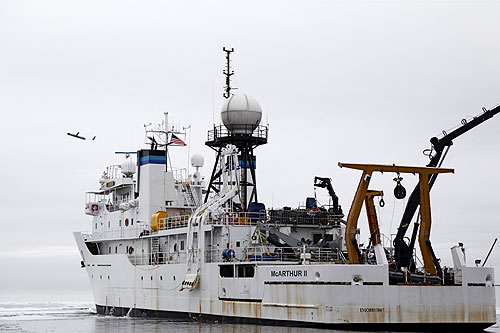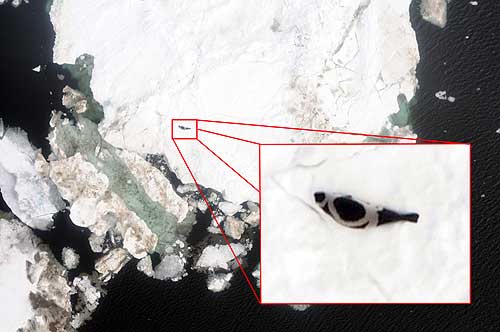 Bering Sea flights prove viability
of university's unmanned aircraft
Bering Sea flights prove viability
of university's unmanned aircraft
June 15, 2009
Monday PM
Fairbanks, Alaska - Researchers can chalk up another accomplishment
for the University of Alaska's Unmanned Aircraft Program. Based
on the seal-observing performance of the program's 40-pound ScanEagles,
researchers have learned the aircraft can operate in snow and
light icing conditions. This feat enhances the viability of
the technology, which has proven useful flying through smoke
and fog during previous scientific flights.
The latest mission coupled
University of Alaska staff with scientists from the National
Oceanic and Atmospheric Administration. The unmanned aircraft
was launched and flown repeatedly from NOAA's ship, McArthur
II, over a series of 30 days in the central Bering Sea.
 A ScanEagle unmanned
aircraft takes off from the NOAA ship McArthur II during a campaign
to locate and capture images of seals in the Bering Sea.
A ScanEagle unmanned
aircraft takes off from the NOAA ship McArthur II during a campaign
to locate and capture images of seals in the Bering Sea.
Photo courtesy Greg Walker.
"We have 42 hours of good flights behind us on this cruise,"
said Greg Walker, manager of the University of Alaska Unmanned
Aircraft Program. "I think we have proven the technology
meets or exceeds the NOAA expectations for performance and the
ability to capture the information they're seeking."
The unmanned aircraft was used
to survey Bering Sea ice floes for bearded, spotted, ringed and
ribbon seals. The ScanEagle flew up to five miles away-as far
as the FAA allowed-from the McArthur II during each survey, capturing
high-resolution images throughout with an onboard camera. The
camera captured more than 25,000 images during the missions.
 A ribbon seal hauled
out on sea ice. The university's unmanned aircraft captured this
image during a mission in the central Bering Sea on June 6, 2009.
A ribbon seal hauled
out on sea ice. The university's unmanned aircraft captured this
image during a mission in the central Bering Sea on June 6, 2009.
Photo courtesy Greg Walker.
The unmanned aircraft that took part in these missions belong
to the University of Alaska. The university purchased its first
ScanEagle "Martha," in May 2006; it now owns and operates
four.
Greg Walker and Don Hampton,
both of Poker Flat Research Range, piloted the unmanned aircraft
during NOAA's seal-mapping mission.
The University of Alaska's
Unmanned Aircraft Program is based at Poker Flat Research Range,
north of Fairbanks.
Source of News:
University of Alaska's Unmanned
Aircraft Program
http://www.afsc.noaa.gov
E-mail your news &
photos to editor@sitnews.us
Publish A Letter in SitNews Read Letters/Opinions
Contact the Editor
SitNews
©2009
Stories In The News
Ketchikan, Alaska
|


